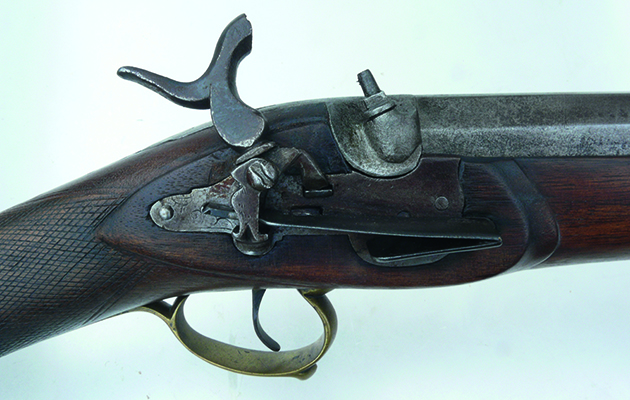Win CENS ProFlex DX5 earplugs worth £1,149 – enter here
Miquelet 8-bore muzzle-loader

For those who still inhabit the world of muzzle-loading, there is always a keen interest in something different. The stranger it is, the more interest it generates and the Miquelet 8-Bore Percussion Muzzle-Loader does sport some unusual features.
A noteworthy lock
Its lock work follows an early and truly classic layout and is of the Miquelet type that originated in Spain in flintlock days, circa 1620, though this example is adapted for a percussion gun. This type of lock is also known as the Mediterranean lock, Spanish lock or, reputedly to the Spaniards, the Patilla lock. Just to confuse things a little more there was also a contemporary Italian version where the mainspring worked the opposite way.
What makes this type of lock so interesting is the outside mainspring and the sears projecting through the lockplate to engage with the foot or toe of the hammer. The sear has a double nose, one for the half-cock “safe” position, the top one for full cock. The toe of the hammer holds the sear noses back until it is pulled past, then each nose independently will pop forward to hold the hammer in place. In the half-cock position, the toe drops into a slot in the sear, effectively locking it in place so it cannot be released by the trigger. On squeezing the trigger with the hammer at full cock, both sears are pulled back into the lockplate allowing the hammer to strike.

A feature of the Miquelet is its Mediterranean lock
Fine detailing
Other features suggest this gun may be of mixed ancestry. The stock, albeit with a shorter forearm, has some of the lines of a musket, especially with the brass butt-plate and trigger-guard. But such gun furniture also appears on early sporting firearms, especially flintlock fowling pieces. It is also made from cherry wood; not so unusual, it seems, on the Continent as it would be in the UK.
As for the barrel bands around the barrel and woodwork, they might be a later addition but there is no doubt that this was always the method of securing the barrels, as there is no provision for any other means of fixing. The barrel is a fine piece of work. It measures up as an 8-bore and externally is part-octagonal, part-round with a fancy banding at the change point between the two shapes. The Belgian Damascus, though now well polished, shows a pattern known as laminette rubans, which translates as laminated ribbons. This is an apt description with each section of curly Damascus pattern being divided by a thin plain ribbon of steel.
Other special features
Unusually for a sporting muzzle-loader, the barrel does not have a hook breech, so it is necessary to remove the breech-pin plus the barrel bands to take the barrel off the stock. However, the breech piece is formed with a proper bolster to mount the nipple rather than the common screwed-in drum and nipple arrangement if it had been converted from a flintlock.
The final odd feature is that the ramrod appears too short. The secret is that the end of the steel ramrod goes right into the butt. This means it has to be slightly offset at a shallow angle to clear the trigger mechanism. It does, though, do away with the need for an under-rib fitted with ramrod loops.
Conclusion
This is a truly fascinating piece of firearms history with three features of note: the laminated ribbon Damascus barrel, the Miquelet lock and the ramrod fixing. Even better, it is in full working order and, while a bit light for an 8-bore, it handles and points well; better even than some more conventional muzzle-loaders.
What to look for when buying a Miquelet 8-Bore muzzle-loader
Barrels: With a muzzle-loader and blackpowder it is always important to check the condition of the bore using a bore light.
Action: Check wear on the lock part; if the sear noses are worn that can result in an accidental discharge.
Weight: 6 ¾lb
Value: With something as unusual as this gun, which may well be unique, its true value could only be determined at auction
Related Articles
Get the latest news delivered direct to your door
Subscribe to Shooting Times & Country
Discover the ultimate companion for field sports enthusiasts with Shooting Times & Country Magazine, the UK’s leading weekly publication that has been at the forefront of shooting culture since 1882. Subscribers gain access to expert tips, comprehensive gear reviews, seasonal advice and a vibrant community of like-minded shooters.
Save on shop price when you subscribe with weekly issues featuring in-depth articles on gundog training, exclusive member offers and access to the digital back issue library. A Shooting Times & Country subscription is more than a magazine, don’t just read about the countryside; immerse yourself in its most authoritative and engaging publication.







